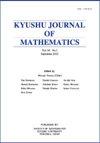非连通曲面上Morse函数的非奇异扩展
IF 0.5
4区 数学
Q3 MATHEMATICS
引用次数: 0
摘要
本文研究了莫尔斯函数在闭合可定向曲面上的非奇异扩展。这种莫尔斯函数的非奇异扩展,是指在以给定曲面为边界的紧致可定向3流形上对无临界点的函数的扩展。1977年,Curley从组合学的角度刻画了关联标记Reeb图上非奇异边界芽的非奇异扩展的存在性。我们应用Curley的结果证明了在一个闭合可定向(可能不连通)曲面上的每一个Morse函数对连通的3流形具有非奇异扩展。本文章由计算机程序翻译,如有差异,请以英文原文为准。
NON-SINGULAR EXTENSIONS OF MORSE FUNCTIONS ON DISCONNECTED SURFACES
In this paper, we study non-singular extensions of Morse functions on closed orientable surfaces. By a non-singular extension of such a Morse function, we mean an extension to a function without critical points on some compact orientable 3-manifold having as boundary the given surface. In 1977, Curley characterized the existence of non-singular extensions of non-singular boundary germs in terms of combinatorics on associated labeled Reeb graphs. We apply Curley’s result to show that every Morse function on a closed orientable (possibly disconnected) surface has a non-singular extension to a 3-manifold that is connected.
求助全文
通过发布文献求助,成功后即可免费获取论文全文。
去求助
来源期刊
CiteScore
0.80
自引率
0.00%
发文量
10
审稿时长
>12 weeks
期刊介绍:
The Kyushu Journal of Mathematics is an academic journal in mathematics, published by the Faculty of Mathematics at Kyushu University since 1941. It publishes selected research papers in pure and applied mathematics. One volume, published each year, consists of two issues, approximately 20 articles and 400 pages in total.
More than 500 copies of the journal are distributed through exchange contracts between mathematical journals, and available at many universities, institutes and libraries around the world. The on-line version of the journal is published at "Jstage" (an aggregator for e-journals), where all the articles published by the journal since 1995 are accessible freely through the Internet.

 求助内容:
求助内容: 应助结果提醒方式:
应助结果提醒方式:


